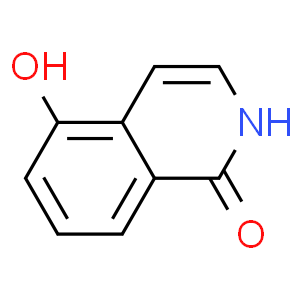基本信息
|
产品编号:I10601 |
|||||
|
产品名称:1,5-Isoquinolinediol |
|||||
|
CAS: |
5154-02-9 |
储存条件 |
粉末 |
-20℃ |
四年 |
|
|
|
||||
|
分子式: |
溶于液体 |
-80℃ |
六个月 |
||
|
分子量 |
161.16 |
-20℃ |
一个月 |
||
|
化学名: |
|||||
|
Solubility (25°C) |
体外 |
DMSO |
30mg/mL (186.15mM; Need ultrasonic) |
||
|
Ethanol |
|
||||
|
Water |
|
||||
|
体内 |
现配现用 |
|
|||
|
<1mg/ml表示微溶或不溶。 |
|||||
|
普西唐提供的所有化合物浓度为内部测试所得,实际溶液度可能与公布值有所偏差,属于正常的批间细微差异现象。 |
|||||
|
请根据产品在不同溶剂中的溶解度选择合适的溶剂配制储备液;⼀旦配成溶液,请分装保存,避免反复冻融造成的产品失效。 |
|||||
制备储备液
|
浓度
溶液体积 质量 |
1mg |
5mg |
10mg |
|
1mM |
6.2050mL |
31.0251mL |
62.0501mL |
|
5mM |
1.2410mL |
6.2050mL |
12.4100mL |
|
10mM |
0.6205mL |
3.1025mL |
6.2050mL |
生物活性
|
产品描述 |
一种 有效的 PARP 抑制剂,IC50 值为 0.18-0.37µM。1,5-Isoquinolinediol 减轻糖尿病诱导的视网膜 NADPH 氧化酶诱导的氧化应激。 |
|
靶点/IC50 |
PARP 0.18-0.37μM (IC50) |
|
体外研究 |
1,5-isoquinolinediol leads to an increase up to 8-fold in the absolute frequency of gene targeting in the correction of the mutation at the stable integrated HSV tk gene. 1,5-Isoquinolinediol is a potent PARP antagonist and decreases cleaved PARP in diabetic retina.1,5-Isoquinolinediol (500μM H2O2; 24 hours) attenuates H2O2-induced upregulation of cleaved PARP-1 expression in retinal Muller cells. 1,5- Isoquinolinediol attenuates diabetes-induced upregulation of retinal nitrated protein expression. 1,5-Isoquinolinediol attenuates diabetes-induced activation of NADPH oxidase in the retina. |
本计算器可帮助您计算出特定溶液中溶质的质量、溶液浓度和体积之间的关系,公式为:
质量 (g) = 浓度 (mol/L) x 体积 (L) x 分子量 (g/mol)
摩尔浓度计算公式
用本工具协助配置特定浓度的溶液,使用的计算公式为:
开始浓度 x 开始体积 = 最终浓度 x 最终体积
稀释公式
稀释公式一般简略地表示为:C1V1 = C2V2 ( 输入 输出 )








